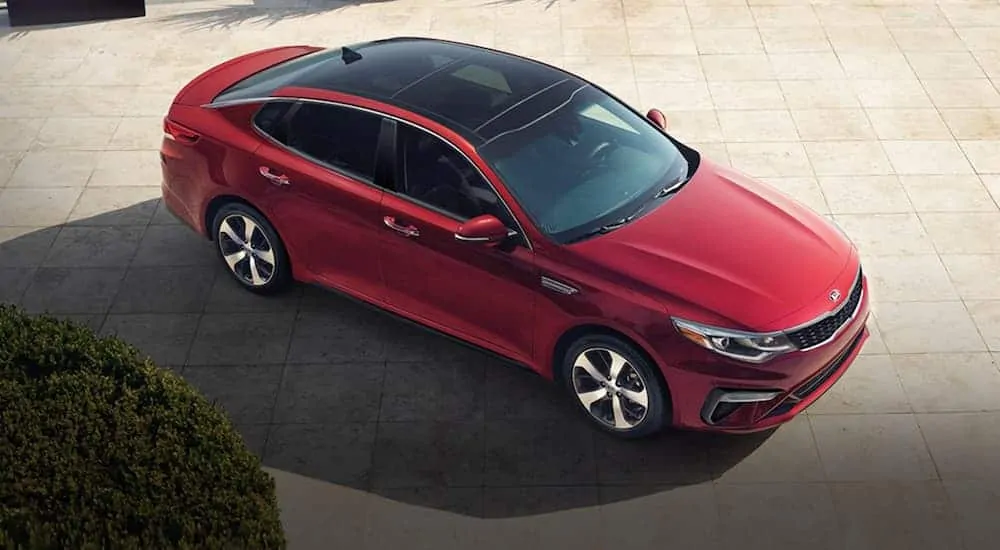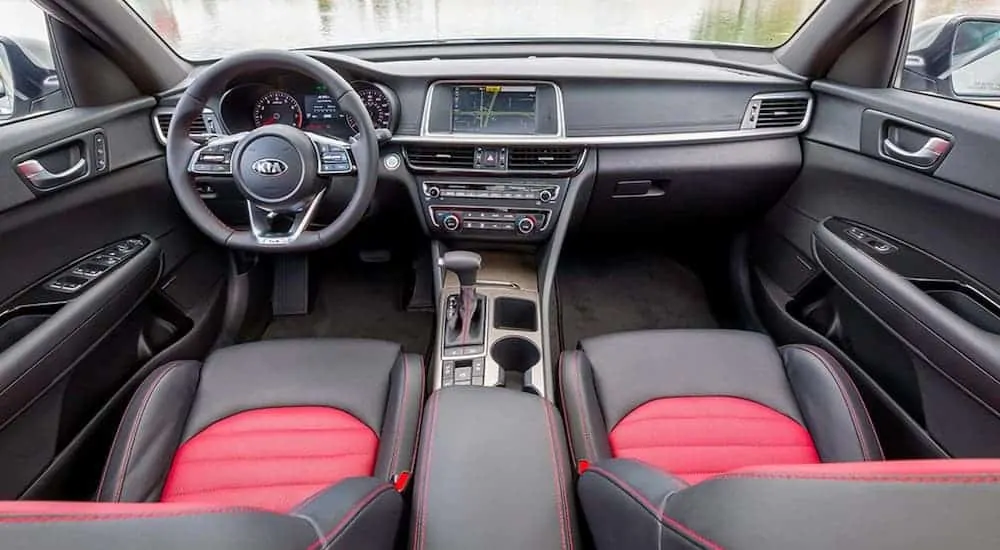Kia has been rapidly moving up in the world. What was once commonly referred to as a “throwaway car” has increasingly become one of the most dynamic auto manufacturers in the world. Although Kia has yet to break into the big leagues in terms of volume, the vehicles that they are currently producing are every bit the equal to those from more established brands. This level of quality from Kia can be seen in comparing the 2020 Kia Optima vs 2020 Toyota Camry. Against the latest midsize sedan from Korea, the reigning market champion from Japan is looking increasingly dated.
Kia Comfort
While the 2020 Kia Optima and 2020 Toyota Camry are virtually identical in their exterior dimensions, Kia has managed to give its midsize sedan significantly more interior volume. The headroom, legroom, shoulder room, and hip room are all greater in the Kia Optima than in the Toyota Camry. To give some hard numbers, the front seats in the 2020 Kia Optima offer 39.8 inches of headroom and 45.5 inches of legroom, while those in the 2020 Toyota Camry have 38.3 inches of headroom and 42.1 inches of legroom.
To top off its victory, Kia even managed to give their car a touch more trunk space than Toyota could provide. This superior use of interior space gives the Korean car a noticeably more comfortable interior for larger people, and even regular-sized passengers will find long drives to be a bit easier to tolerate than in the Toyota Camry. However, the comfort advantage of the Kia Optima is far from limited to raw space alone.
For instance, in terms of major equipment, half of the trims of the 2020 Kia Optima come standard with a massive panoramic power sunroof that stretches across both the front and back seats. And while the 2020 Toyota Camry also offers a panoramic power sunroof, it is only available as standard equipment on the top of the line XLE V6 and XSE V6 trims. With all of the other trims of the Toyota Camry, you must pay extra for this valuable feature, and the car’s lowest trims can only be optioned with a smaller single-pane sunroof that just covers the front seats.
It is not that Kia has chosen to include high visibility options to make its car seem better. Even subtle details of the Optima have been carefully engineered to produce a more comfortable driving experience. For instance, the EX and higher trims of the 2020 Kia Optima are equipped with sound-absorbing glass in their front side windows. This feature significantly cuts down on road noise and is usually only found in genuine luxury vehicles. Altogether the Kia Optima is a genuine upgrade in comfort over the Toyota Camry, despite having a lower price point.
Kia Tech
These physical features are actually not Kia’s strongest point, where the Korea brand truly excels is in its level of technology. Both the infotainment and safety technologies in the Optima have long been ahead of those in the Camry. Lately, however, Toyota has appeared to realize its technological inferiority and has finally begun adding modern tech features to its vehicles. While the comparison is now closer than before, Kia still has the lead.
When it comes to infotainment systems, every trim of the 2020 Kia Optima comes standard with an 8-inch central touchscreen mounted high on the dash for excellent visibility while driving. In contrast, most trims of the 2020 Toyota Camry come standard with a smaller 7-inch touch screen. Further, the Japanese car has its screen located low on the dash below the air conditioning vents, forcing you to take your eyes off the road if you wish to view it.
In addition to its superior visual interface, the Kia Optima also has higher quality audio equipment available. While the highest trims of the 2020 Toyota Camry can be equipped with an optional nine-speaker JBL sound system for an additional fee, the top trims of the 2020 Kia Optima come standard with a ten-speaker Harman Kardon premium surround sound setup. This is just yet another example of how Kia does not just compete by providing higher value cars, but by providing higher quality cars as well.
Advanced Safety
Because of their advanced safety technologies, both the 2020 Kia Optima and 2020 Toyota Camry were named as a Top Safety Pick+ by the prestigious Insurance Institute for Highway Safety. However, the only advanced safety technology covered by the IIHS test regime is automatic emergency braking. When it comes to other advanced driver assistance features, the Kia Optima has a clear advantage.
The standard Toyota Safety Sense P suite included on all trims of the 2020 Toyota Camry is limited to automatic emergency braking, automatic high beams, lane departure alert, and active cruise control. In contrast, the standard advanced safety technologies for the 2020 Kia Optima include blind-spot warnings with both lane change assist and rear cross-traffic alert, reverse parking assist sonar, and a full lane-keeping assist system that will automatically provide corrective steering as well as alerts. While Toyota does offer a similar set of equipment, it is only available by adding optional packages to the top trims of the car. So while it might not be reflected in the IIHS ratings, the availability of advanced technology on the 2020 Kia Optima gives it a significant edge in safety over the 2020 Toyota Camry from the parking lot to the highway.
Performance
As strange as it might seem given the Camry’s reputation as a boring car, the one place where the 2020 Kia Optima is not the clear winner over the 2020 Toyota Camry is when it comes to performance. None of the three drivetrains in the Optima can match the Toyota options when it comes to either power or efficiency, and the Camry even has the added advantage of its optional all-wheel-drive system. However, this deficiency is not surprising given the relative ages of these two cars. The current Optima was introduced for the 2016 model year and takes many elements from the 2015 Hyundai Sonata. Meanwhile, the current Camry generation hit the market for the 2018 model year and only received all-wheel-drive for the 2020 model year.
However, the lower performance of the 2020 Kia Optima will soon be more than corrected by the upcoming launch of its successor, the 2021 Kia K5. This new car will offer a significantly more capable selection of drivetrains that will close the gap with the Toyota Camry in terms of both performance and efficiency. The Kia K5 will also have an all-wheel drive option, making Toyota’s advantage in that area extremely short-lived.
Today, cars like the 2020 Kia Optima more than demonstrate how far Kia has come in a very short time. To be able to build a car that equals or exceeds the iconic Toyota Camry in so many categories reveals the strength of Korea’s automobile industry. And with a new generation of even better vehicles such as the 2021 Kia K5 waiting in the wings, we should expect Kia to continue to take market share from its more established competitors.






